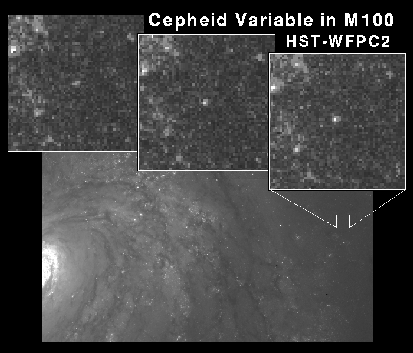Explanation: Can this blinking star tell us how fast the universe is expanding? Many astronomers also believe it may also tell us the age of the universe! The photographed "Cepheid variable" star in M100 brightens and dims over the course of days as its atmosphere expands and contracts. A longer blinking cycle means an intrinsically brighter star. Cepheids variable stars are therefore used as distance indicators. By noting exactly how long the blinking period is and exactly how bright the star appears to be, one can tell the distance to the star and hence the star's parent galaxy. This distance can then be used to match-up easily measured recessional velocity ("redshift") with distance. Once this "Hubble relation" is determined for M100, it should be the same for all galaxies - and hence tell us how fast the universe is expanding. The exact magnitude of this calibration is under dispute and so a real live debate involving the value of Hubble's constant titled "The Scale of the Universe" will occur in April 1996 in Washington, DC.
Authors & editors:
Robert Nemiroff
(MTU) &
Jerry Bonnell
(USRA)
NASA Web Site Statements, Warnings,
and Disclaimers
NASA Official: Jay Norris.
Specific
rights apply.
A service of:
LHEA at
NASA /
GSFC
& Michigan Tech. U.
Based on Astronomy Picture
Of the Day
